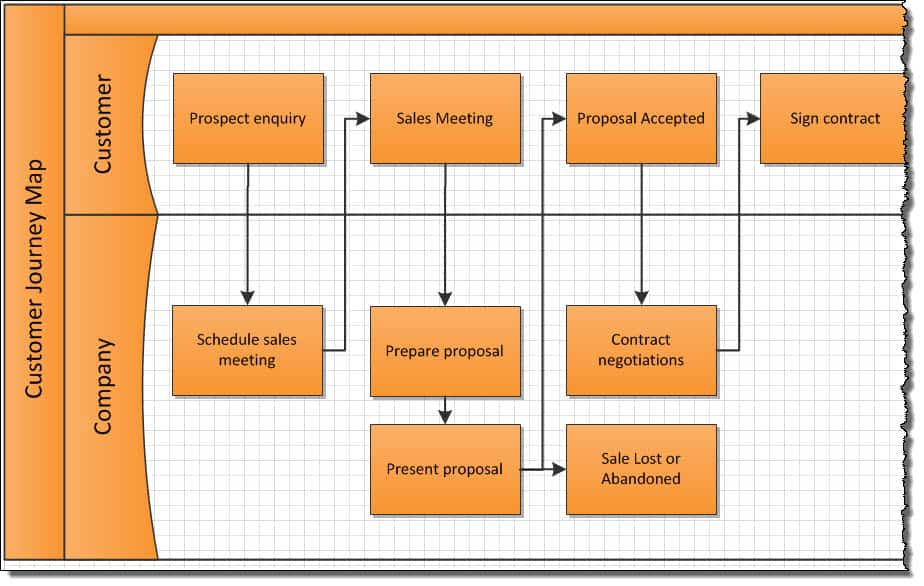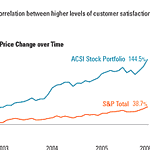Transactional customer feedback is a very effective way of improving business performance. With it you can diagnose problems and processes that are driving customers away and reinforce the drivers of customer loyalty in the business.
But how do you decide which transactions should be included?
What is a Customer Journey Map?
Customer Journey Maps document the interactions that customers have with your business before, during and after their relationship with you.
With so many practitioners using them, there are many different forms of customer journey maps; none of them right or wrong, just used in different ways.
Some are circular, some include the Awareness phase of the marketing cycle, and others include estimates of the customer’s emotional state at each point in the process. All however, attempt to understand and document the customer’s experience with the organisation.
My preferred approach is to map out the trackable elements of the customer experience and include some internal processes. This allows clients to easily apply the customer journey map information to the design of the transactional customer feedback data collection process.

As you can see above, we split the map into two sections: Customer initiated and Company initiated. We also include some internal processes that the client does not see so that they can be picked up in the next stage.
Why Use Customer Journey in Customer Feedback?
One of the key benefits of transactional customer feedback is gathering information around each of the key touchpoints in the business. If done in a consistent manner you can then apply Pareto analysis to the feedback on each touchpoint to determine where to invest your time for maximum benefit.
Merging Journey Maps and Customer Feedback
In complex businesses you should not attempt to translate the entire touchpoint map into active transactional customer feedback data collection on day one. This is simply because some data will be harder to access than others. You are better off prioritising your data collection to focus on the more important, easy to collect data first and then build out to the complete map over time.
If you try to start with 100% coverage of your customer journey map you may never get the process up and running. At the very least you will delay the launch beyond when you could be acting to improve the customer experience.
When you have constructed your journey map you should analyse it to prioritise touchpoint data collection using the following four factors:
1. What Data Do We Have Access to Today?
First determine what data is actually being collected in a usable manner. For each touchpoint identify which system (manual or automated) records the customer’s transition across that Touchpoint. Then determine if you can extract that data in a useful way.
Examples of a transition across a touch point include:
- Account manager switches the prospect status to “sold” or “lost” in the CRM system. This is relatively easy to extract.
- Shipping system issues a consignment note. This would also be a very easy transaction to capture.
- Contact centre representative leaves a text note in the customer record about a call from a customer. This would be very difficult to extract and use because it is a free format text.
You can see that even though the organisation might record the transition across the touchpoint the data might not be easy to use. Focus initially on data that is easy to extract and use.
2. Which are the High Value Interactions or Moments of Truth
In any customer journey there will be more important touchpoints (e.g. customer places order) and less important touchpoints (e.g. customer downloads user manual).
Try to focus initially on the higher value touchpoints for your business. This may be difficult to determine empirically because you will have no initial data but use the knowledge and skills in your organisation to make an educated guess.
3. Identify the High Volume Transactions
Initially you should also look for high volume transactions. In a transactional customer feedback environment this will provide more reliable data more quickly and allow you to act sooner.
Also, improvements in high volume transactions will often have a larger combined impact on the overall business than changes in low volume transactions.
4. Capture High Value Customer Segments
Focusing on important or large customer segments is like focusing on the high volume transactions. It will naturally focus you on the important parts of the business.
Update the Customer Journey Map with Targeted Touchpoints
At the end of this process you should have a customer journey map that shows the prioritised data feeds that you want to drive into your customer feedback process.
Now the task is relatively straight forward. Simply work with your data analytics or IT team to methodically get each data feed up and piped into your transactional customer feedback system.
They don’t all have to be completed on day one. Just lay out a plan to bring them all into line at some point.
Using the customer journey map to plan out your transactional customer feedback execution ensures that you start collecting the right data about the right touch points in the right order. That will help you to drive the maximum impact from the continuous improvement process.
Get the Business Leader's Guide to Net Promoter Score Download Here






